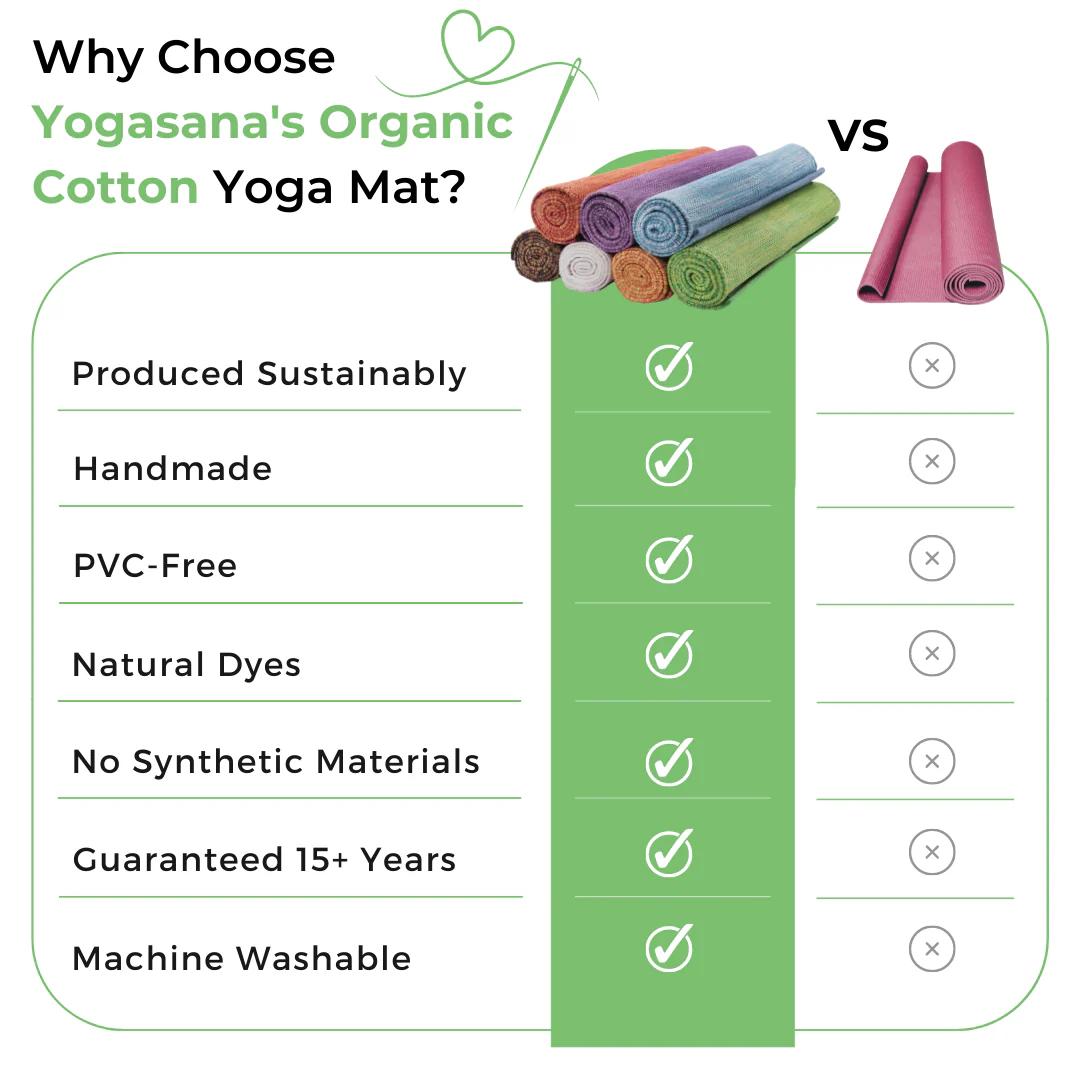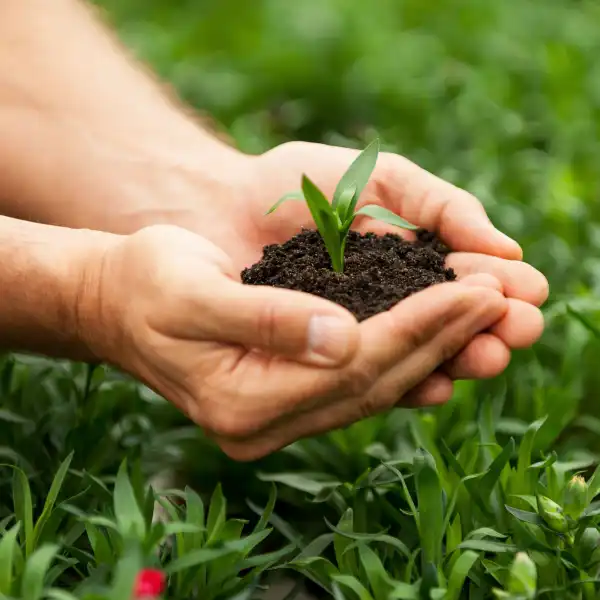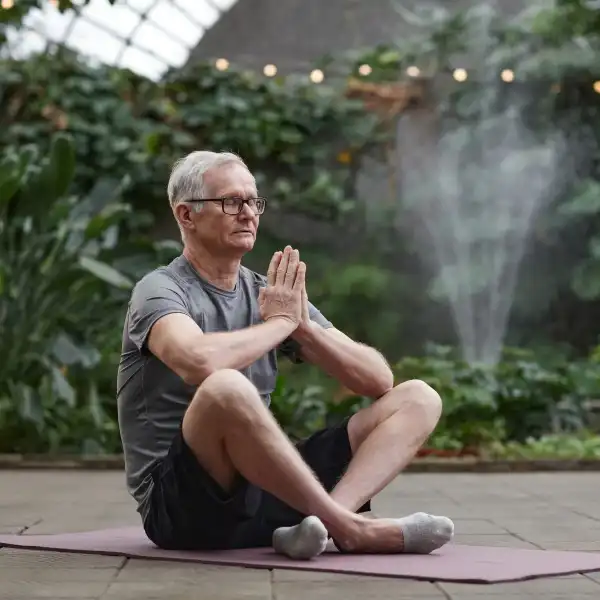There are many yoga mat materials available and eco-friendly yogis have the option to choose a natural rubber yoga mat, a cork mat or a cotton mat.
Natural Rubber Yoga Mat

Yogis are often surprised that rubber can be made into yoga mats. Resin is harvested from rubber tress which go through a fermenting process, then machines to cut and create the yoga mats. These mats are often described as having a combination of natural and man-made components.
Cork Yoga Mat

Yoga products made of cork have gained popularity recently due to their sustainability. Cork is a natural product – it is harvested by peeling the bark off the trees (they never have to be cut down).
Cotton Mat
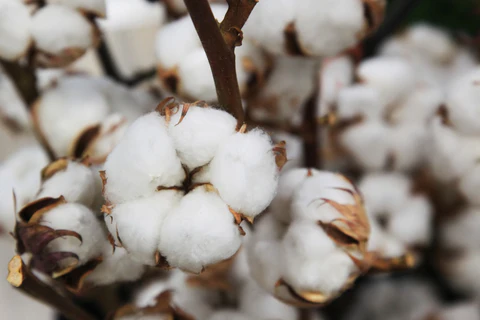
Cotton yoga mats offer a traditional and classic platform for yoga practice. These mats are not only made of natural materials, it is hypoallergenic, keeps the body cool and does not pollute the environment.
In the Beginning, There Was Yoga
Yoga has been practiced without mats for a thousand years. From its beginnings in India, the yoga sutras, as codified by Patanjali, formed the theory and practice of the art of yoga.
The science of yoga is based on a meditative and spiritual tradition, as described by Master Patanjali. He wrote of Ashtanga yoga as having eight limbs with the asanas being one of these parts.
Ultimately, the goal for the yogi is to unite the self/soul with its essential nature and, in the end, find liberation and achieve Samādhi.
For the physical part of the journey, the practice consisted of asanas, that were initially performed on the ground without the aid of any foundation or mat. Eventually, early yogis began to use deer, tiger, and various animal skins.
Cloth made of natural materials became popular in the 1800s as the postures advanced and became more physically challenging. Cotton and wool rugs were used to provide a better base with cushioning and stability.
The Introduction of Plastic or “Sticky Mats”
In the 1960s, yoga gained popularity in the West. The introduction of the so-called ‘sticky mat’ began with a yogini named Angela Farmer. She believed it would be more comfortable to use foam carpet as padding and created an innovative makeshift mat out of it.
By the 1990s, Sara Chambers had innovated a much durable and sturdy mat specifically designed for asana practice. The ‘sticky mat’ took hold in the modern yoga practice.
Yoga has since become a billion-dollar business. Mass-produced mats, machine-made of PVC (polyvinyl chloride) or other extruded plastic-based materials have become more popular. They’ve been widely used today because of convenience.
PVC is made from reacting chlorine, carbon, and ethylene (a product of petrol) together. Later, phthalates are added to the mix to make it soft and pliable.
The basic raw materials for PVC are derived from salt and oil. The electrolysis of saltwater produces chlorine. The chlorine is then combined with ethylene that has been obtained from oil. The resulting element is ethylene dichloride, which is converted at very high temperatures to vinyl chloride monomer. This is all highly reliant on the use of fossil fuels.
The result is a cheap and cheerful yoga mat- but how long will it last? A PVC mat is initially a cheaper option, but over time, it can cost the yogi much more.
What’s the Final Destination for a Pvc Mat After Its Usefulness Is Exhausted?
The options for reuse or recycle are limited. PVC requires further chemical processing to transform a mat into another PVC product.
Most PVC mats are destined for landfills. Some end up contributing to the toxic problem of plastic waste in our oceans. It’s estimated that every year, approximately 1.6 million barrels of oil are used just for producing plastic water bottles. Plastic can take up to 1,000 years to decompose in landfills!
Practicing yoga on these types of materials may have a deleterious effect on the well-being of a yogi and should be avoided when possible.
Are Yoga Mats Really Necessary?
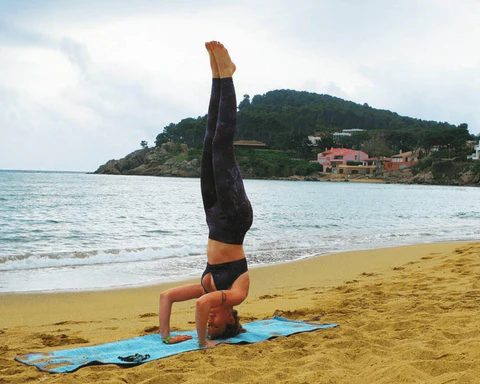
Consider the yoga mat as a smart investment that provides many benefits. It is an essential accessory that allows you to practice yoga in the indoor and outdoor settings, allowing you do physical postures (asanas) safely and effortlessly.
- It prevents slipping. Yoga involves stretching and positioning the body in ways that can cause slipping. The body is prone to fatigue and muscle cramps that lead to slipping with hands and feet. It is more likely to happen when you are practicing yoga on smooth surfaces like wood, or a polished floor. A yoga mat provides support on the surface and secures and protects protruding bones and knee joints.
- It allows for balance and alignment. The yoga mat helps you sustain the right balance and body alignment, even if you are sweating profusely. Perspiration on the mat increases the risk of injury and makes poses more difficult to accomplish. Finding a mat with the right grip is important for Ashtanga yoga or hot yoga.
- It provides an adequate cushion. Yoga positions like table pose, lunges, and kneeling require enough cushion to protect the joints from injury and sustain the poses longer. It is vital to find a yoga mat with adequate thickness. The extra layer will also insulate your body against the warm or cool surface.
- It ensures proper hygiene. No matter how clean the floor of the yoga studio or the gym seems to be, the risk of infection is always possible. Using your own yoga mat gives an assurance that you are safe from unseen bacteria and unpleasant smell when borrowing a studio mat.
- It defines personal space. Yoga mats are more than just tools for yogis; they represent mental and physical spaces that offer relief from the unpredictable events of the day and stressful situations. They encourage freedom and flexibility. Your yoga mat acts as a boundary of your private space, allowing you to stretch your worries and tensions away.
- It sets a positive trigger. A rolled yoga mat within your sight reminds you of your scheduled routine. The act of rolling out your mat represents your intention and commitment to your practice. It may be just a tool, but a yoga mat becomes a symbol of a mindful choice and freedom to pursue your practice, to sustain a healthy and happy lifestyle.
Avoiding Plastic Yoga Mats
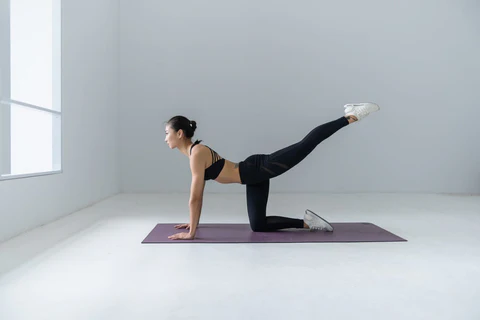
Do you know that the material of your yoga mat can affect your breathing? One of the vital parts of yoga practice is proper breathing. Plastic yoga mats have both health and environmental impact, considering that PVC is a toxic material because it has lead content and other heavy metals that make it more stable. When buried or incinerated, it releases a carcinogen called dioxin.
Avoid compromising your health with cheap, conventional mats and consider safer alternatives. Here are examples of the eco-friendly yoga mat materials:
| Yoga Mat Type | Material | Cost | Advantages | Limitations |
|---|---|---|---|---|
| Rubber | Natural Rubber | $50-$110 | – Sustainably harvested – Non-toxic and non-latex – Recyclable and eco-friendly – Provides soft cushioning – Exceptional grip – Absorbs sweat – Heavy-duty, great for fast-paced yoga or heated space |
– Heavy – Takes time to dry – Hard to clean – Not suitable for latex allergies – Smell of rubber – Limited lifespan (18 months – 2 years) |
| Cork | Cork | $30-$130 | – 100% natural and biodegradable – Tree-friendly harvesting – Antimicrobial – Lightweight – Durable and non-slippery – Strong grip and cushion – Non-toxic, free of glues – Fire retardant |
– Thinner, cheaper mats can chip – Needs non-slip backing – Harder surface – Rubber backing can separate – Heavier compared to other mats |
| Jute | Jute | $30-$100 | – Organic, biodegradable, and eco-friendly – Thin and lightweight – Non-toxic, phthalate-free – Breathable, durable – Great grip – Latex-free, antimicrobial |
– Rough texture – Limited cushioning – Hard to clean |
| Cotton | Cotton | $30-$100 | – Organic, breathable, hypoallergenic – Durable and resilient – Easy to clean – Better grip with perspiration – Lightweight and portable – Skin-friendly and sustainable |
– Less cushioning – Firm surface, may feel coarse |
| Bamboo | Bamboo-fibre | $50-$130 | – Ecologically-friendly – Sturdy, cushioned surface – Easy to maintain – Portable and versatile – Absorbs odor and sweat |
– Moisture weakens fibers – Requires regular replacement |
| Hemp | Hemp | $50-$130 | – Natural, organic, biodegradable – Free of rubber/latex – Ultra-durable – Bacteria-and-mold-resistant |
– Scratchy |
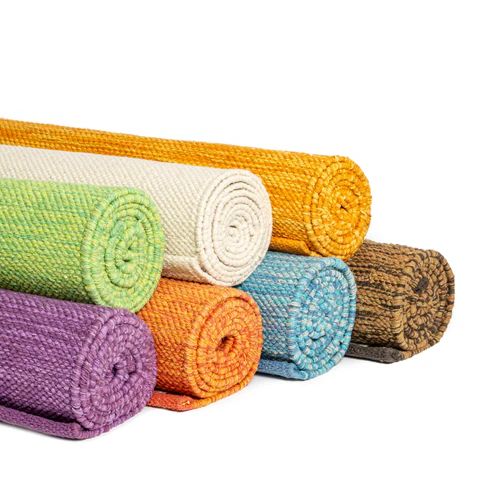
Choosing the Right Yoga Mat
Your mat will accompany you on your wellness journey, finding the right one is essential. It should be based on your personal style and preferences to get the optimum benefits for your yoga practice. Whether you are a beginner or an advanced yogi who wants to upgrade an entry-level mat, here are the factors you need consider when choosing the best/most advanced yoga mat for you.
Manufactured Yoga Mat Material vs Natural Yoga Mat Materials
The composition of the material significantly impacts your performance. It influences the texture, sponginess, and stickiness of the surface, helping you keep a perfect balance and feel safe while doing yoga poses.
- PVC (Polyvinyl chloride). Entry-level or basic yoga mats are mostly made of PVC. It typically offers enough stickiness, comfort, and durability. It is easy to clean and provides a strong floor grip. However, PVC is non-absorbent, which makes the mat’s surface slippery when you are sweating heavily. Moreover, it is not biodegradable and environmentally-friendly. Many yogis are also concerned about the potential negative human health affects with using plastic.
- Foam/Thermoplastic elastomer (TPE/PER). These materials are a combination of plastic and rubber polymers. Compared to PVC, it is more earth-friendly and non-toxic. Some are even fully recyclable. However, foam material contains latex, which is not preferred for yogis with allergies.
- Cotton. This material is often referred to as classic/traditional’. Cotton absorbs sweat with ease, providing excellent support and traction when wet. It’s also easy to clean.
- Rubber. There are two kinds of rubber- natural and synthetic. Natural rubber is more heavy-duty, durable, sturdy, and sweat absorbent. Synthetic rubber is usually used in mass production of yoga mats and cheaper than natural rubber.
- Jute. Like cotton, jute is often used over other yoga mats for superior support and traction. However, it is more fibrous and rougher, making it less absorbent.
- Bamboo. It is an earth-friendly option and provides ultimate support. It maintains a flat and even surface, even if you are practicing in the outdoors.
- Cork. This material is becoming more and more popular because of its many benefits, which include biodegradability and antimicrobial property.
Texture
Texture affects the amount of traction that yoga mats provide. It serves as a physical barrier that helps you sustain proper body alignment and balance. Without adequate grip and texture, you are prone to sliding and slipping. The better traction, the greater is your overall comfort and performance.
Yoga mats that are made of jute, rubber, and cotton with raised texture are the best choices. The textured pattern will sustain your balance no matter how vigorous the pose or amount of perspiration.
Thickness
The average thickness of yoga mats is ⅛ inch thick (3.175 mm). It allows optimum performance, letting you have easy, strong, and flowing practice. It sustains your solid contact with the ground, which is necessary for various poses. Moreover, it will not get in your way and let you shift from one position to another.
Thinner Mats provide stability for focused and active yoga poses. To get the maximum benefits, opt for a mat with a textured surface because it delivers a better grip during strenuous poses. Travel mats that are thin, lightweight, and easy-to-fold.
Thicker Mats are perfect for therapeutic practices like restorative yoga because they offer extra cushioning. Find one with a softer surface to make you more comfortable in holding more challenging poses. If you are thin and slender, find a thicker mat with ¼ inch thickness to avoid hurting your hip bones when you press them into the ground during the practice. It also applies to people with sensitive joints. If this isn’t an issue, it’s best to stick to the standard thickness because the added cushion of thicker yoga mats makes it more difficult to achieve the perfect balance. It also makes the mat bulkier and heavier.
Cost
The price of yoga mats usually depends on the material, thickness, and other decisive factors that significantly affect the users’ practice. A high quality, patterned, and an antimicrobial-treated yoga mat is more expensive compared to basic, solid-colors and plain mat. PVC yoga mats are cheaper than mats made of high-end, eco-friendly options.
Regarding price, the willingness to invest in a mat that will provide you maximum benefits and value will pay dividends. A higher initial cost of a well-made mat may be a better investment over an inexpensive mat or one that must be replaced frequently.
Sustainability
Sustainability is important to most practitioners of yoga. The best choices are eco-friendly mats that are made of organic cotton, jute, cork, or natural rubber. Avoid buying PVC and synthetic-made yoga mats that contain harmful chemicals or substances that are hazardous to health and the environment.
Type of Practice
The style of yoga is another vital factor when choosing the right mat. If you are practicing power yoga and other active types that require a lot of stretching, bending, and sliding, you need textured mats that are made of high-quality natural materials. A super-absorbent mat with excellent traction is best for Vinyasa or Ashtanga practices. Avoid foam or PVC mats because they become slippery when you start perspiring.
For Yin yoga, Hatha yoga, and other gentler styles, a natural mat with excellent traction is a good choice. Restorative yoga and other lower-intensity yoga require a material that provides stronger support and better comfort because of long periods of lying down. Longer mats are always preferred during shavasana at the end of your practice. Natural mats are also a great part of a gentle, evening self-care night yoga practice, allowing you to unwind from the stresses of the day (without having to inhale the chemicals) and
Location of Practice
The venue of your practice matters. If you primarily practice at home, you can opt for a thicker and heavier mat. But, if you prefer to practice in a studio, consider a lighter mat so you can carry it with ease. However, do not compromise the quality, thickness, and material of your mat just because you want a lighter load.
Why Choose an Eco-Friendly Yoga Mat?

A main objective of practicing yoga is to feel a sense of centeredness. The choice of mat can affect this feeling. Choosing a mat made of natural materials offers these additional benefits:
Allows Natural Energy Flow
Yoga is about your connection to your essential self (true self). It involves a deep focus to awaken the source of energy in your body, letting energy flow, and allowing it to energize the vital organs during the asanas. This energy or life force moves and circulates inside simultaneously, creating harmony and enhances your well-being.
When the asana or yoga pose is perfected by the practitioner, there is a subtle energy that descends from your crown to your toes, and into the earth. A mat made of natural materials allows the energy to flow from head to toe, grounding the posture. Rubber and plastic are insulators and inhibit the flow, effectively blocking it.
Social Responsibility
Eco-friendly yoga mats are manufactured by companies and entrepreneurs who are environmentally conscious and socially responsible. They believe in the balance of nature and profits, translating their products to advocate the use of organic and user-friendly materials that help protect the Earth.
Furthermore, many natural yoga mats are handwoven, which creates employment for poor communities. One way to this social cause is to choose a mat from a company that’s committed to this ideal. India has workers who make handcrafted mats to sustain and support their families. The art of weaving rugs and mats dates to the 13th century and the time of Master Kabir – who earned his living as a weaver. Buying a hand-woven yoga mat of Indian origin helps to ensure the next generation of weavers can continue the handcraft in the professional lineage of Kabir.
Sustainability & Longevity
Eco-friendly mats can be more expensive compared to synthetic plastic mats, but the investment can come with a guarantee of longevity. The convenience of buying a cheap PVC mat can come at the cost to your health and environment. Frequent replacement means this may not be the best choice in the long run.
Choosing an eco-friendly mat is a better choice for the environment. The eco-disadvantages of PVC mats have been explained here. Other eco-type mats offer rapid decomposition in landfills as a benefit. Mats made of natural materials, like organic cotton, can become a rug in a home after years of service to the yogi — and never end up in landfills.
Outdoor use
Practicing yoga in the outdoors is believed to be more effective because it allows a stronger connection with nature. The body releases more positive energy and serotonin, boosting the overall performance. It promotes an immersive and sensory practice, helping you replenish the depleted energy.
To optimize your outdoor yoga experience, use an eco-friendly mat. Some eco-mats made of natural materials suffer from extended time in the sun. This exposure is generally not covered under the warranty. Other natural materials (cork/cotton) can withstand the heat of the sun and last much longer, without affecting the guarantee.
Grip. Grip. Grip.
A yoga mat with the right grip is extremely important to help you balance and perform the asanas, even if you are perspiring heavily. Sweat on the mat’s surface, usually makes it difficult to do the required poses properly, causes accidental skidding, and increases the risk of injury. A lot of rubber and plastic mats tend to become slippery when wet because they do not absorb moisture. On the other hand, yoga mats that are made of natural fiber and other eco-friendly materials that absorb sweat or water moisture well, ensuring your safety.
Two for the price of one
Opting to use an eco-friendly mat is a choice that works in two ways. First, you allow its transformative power to make you a better person inside out, in terms of physical, mental, and emotional states of health. Second, it gives you an opportunity to become an agent of change because you choose sustainability. It’s like buying two for the price of one.
One eco-friendly yoga mat will go a long, long way of togetherness. One high-quality mat of this kind is equivalent to two cheap plastic mats. It has a longer life span and easier to clean. Another advantage is it usually has an anti-bacterial surface, or the organic material itself is antimicrobial.
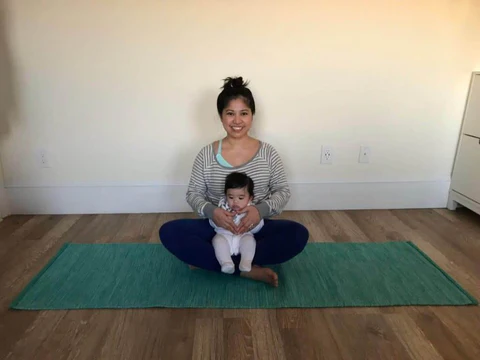
Conclusion: Choose the Non-toxic, Natural Yoga Mat Material
The type of yoga mat you choose matters; the right material will maximize your performance, creating a holistic experience that promotes the highest level of physical, mental, and spiritual well-being. It is not just a yoga accessory, but a tool that will be your constant partner towards a better you.
It makes yoga more magical, allowing you to delve effortlessly within your consciousness and connect with your inner self. In more advanced yoga practice, it helps you connect with your Higher Self, which is the penultimate level that everyone wants to achieve.
It makes yoga more magical, allowing you to delve effortlessly within your consciousness and connect with your inner self. In more advanced yoga practice, it helps you connect with your Higher Self, which is the penultimate level that everyone wants to achieve.
Practicing yoga with an eco-friendly mat is a decision that impacts your lifestyle, becoming more aware of choosing happiness, kindness, non-violence, sustainability, and compassion. In essence, it is your first step toward a better world and earthly existence. Make the best choice for you and the environment
